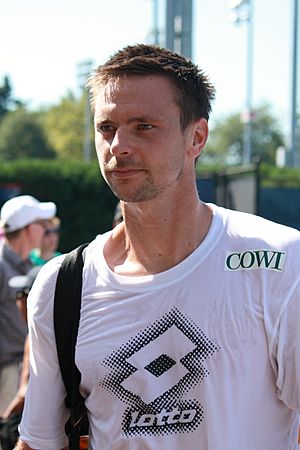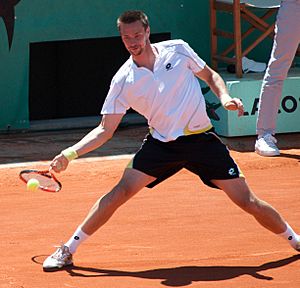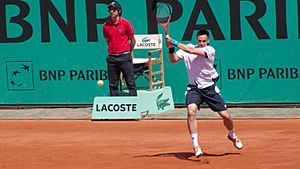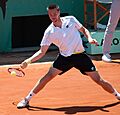Robin Söderling facts for kids

Robin Söderling at the 2010 US Open
|
|
| Full name | Robin Bo Carl Söderling |
|---|---|
| Country (sports) | |
| Residence | Monte Carlo, Monaco |
| Born | 14 August 1984 Tibro, Sweden |
| Height | 1.93 m (6 ft 4 in) |
| Turned pro | 2001 |
| Retired | 2015 (last match July 2011) |
| Plays | Right-handed (two-handed backhand) |
| Prize money | US$10,423,124 |
| Singles | |
| Career record | 310–170 (64.6%) |
| Career titles | 10 |
| Highest ranking | No. 4 (15 November 2010) |
| Grand Slam singles results | |
| Australian Open | 4R (2011) |
| French Open | F (2009, 2010) |
| Wimbledon | QF (2010) |
| US Open | QF (2009, 2010) |
| Other tournaments | |
| Tour Finals | SF (2009) |
| Olympic Games | 1R (2004, 2008) |
| Doubles | |
| Career record | 33–43 (43.4%) |
| Career titles | 1 |
| Highest ranking | No. 109 (9 May 2009) |
| Grand Slam doubles results | |
| Wimbledon | 2R (2005) |
| US Open | 2R (2004, 2005) |
| Team competitions | |
| Davis Cup | SF (2007) |
Robin Söderling (born August 14, 1984) is a Swedish former professional tennis player. He was known for his powerful game. In November 2010, he reached his highest ranking as world No. 4 in men's singles.
Robin won ten singles titles on the ATP Tour. He reached the finals of the French Open two times in a row, in 2009 and 2010. He also won a Masters title at the 2010 Paris Masters. Robin was the first player to beat Rafael Nadal at the French Open. He played his last professional match in July 2011 at age 26. He had to stop playing because he got sick with mononucleosis.
Contents
Robin Söderling's Tennis Journey
Robin Söderling started playing tennis when he was five years old. He played his first junior tournament in Luxembourg in November 1998, when he was 14.
Becoming Famous at the French Open
Robin became well-known at the 2009 French Open. He was the first player ever to defeat Rafael Nadal at this tournament. Before Robin, Nadal had never lost there since his first time in 2005. Nadal had won the tournament four times in a row.
After beating Nadal, Robin reached the final. He defeated Nikolay Davydenko and Fernando González on his way. In the final, he lost to Roger Federer.
Robin reached the French Open final again in 2010. He beat defending champion Federer in the quarterfinals. This ended Federer's amazing streak of 23 Grand Slam semifinals in a row. Robin then won his semifinal match against Tomáš Berdych. However, he lost to Rafael Nadal in the final.
Retirement and New Roles
After getting sick and injured, Robin did not play any tour matches after winning the 2011 Swedish Open in July 2011. At that time, he was ranked No. 5 in the world. He was only 26 years old and had been in the top 5 for over 50 weeks.
On December 23, 2015, Robin Söderling announced he was retiring from professional tennis. He had not played a match for over four years due to his illness. He also shared that he had struggled with anxiety and panic attacks since July 2011. In July 2020, he announced he was "completely healed."
Since 2014, Robin has been involved in tennis in other ways. He was a tournament director at the Stockholm Open in 2014 and 2015. He also started his own brand of tennis gear in 2013.
Early Career and First Wins
Robin turned professional in 2001. He played his first ATP tournament in Stockholm and won his first match. In 2003, he reached the third round at Wimbledon and made it to an ATP final in Stockholm. He finished that year ranked 86th in the world.
Robin won his first ATP title in 2004 at Lyon. He also reached another final in Marseille. By the end of 2004, he was in the world's top 50.
In 2005, Robin had a knee injury and needed surgery. Even with injuries, he won another title in Milan. He had another surgery after the US Open.
In 2006, he recovered from his injuries. He helped the Swedish team stay in the World Group of the Davis Cup. He ended the year ranked No. 25, which was his highest ranking at that time.
In 2007, Robin reached the third round at Wimbledon. He lost to Rafael Nadal in a close five-set match. He also reached two finals in Rotterdam and Memphis, but lost both.
In 2008, Robin had a great year at the 2008 World Team Cup in Düsseldorf. He won all his singles and doubles matches, helping Sweden win the team event. He reached his third final of the year in Stockholm, but lost. Three weeks later, he won his second title at the Lyon tournament. He beat top players like Andy Roddick and Gilles Simon. This win helped him reach a new career-high ranking of No. 18. He finished 2008 ranked No. 17.
2009: Reaching the Top 10
In 2009, Robin started working with a new coach, Magnus Norman. At the French Open, Robin, ranked 23rd, reached the fourth round of a Grand Slam for the first time. He then caused a huge upset by beating Rafael Nadal. This ended Nadal's 31-match winning streak at the French Open. Many people called it one of the biggest upsets in tennis history. Robin then reached his first Grand Slam final, but lost to Roger Federer. After this, his ranking went up to 12th in the world.

At Wimbledon, he reached the fourth round for the first time. He lost to Federer again. After Wimbledon, Robin won the Collector Swedish Open in his home country. This was his first outdoor title.
Robin continued to play well, reaching the quarterfinals at the US Open. He lost to Roger Federer again. In October 2009, Robin officially entered the top 10 rankings for the first time. He finished the year ranked No. 8, which was a new career-best.
2010: Another French Open Final and Career High
Robin started 2010 by winning the ABN AMRO World Tennis Tournament. This was his biggest tournament win at that time. He also reached the semifinals at the 2010 BNP Paribas Open and the 2010 Sony Ericsson Open.
At the French Open, Robin was ranked 5th. He defeated Federer in the quarterfinals, breaking Federer's record of 23 straight Grand Slam semifinals. Robin reached his second French Open final in a row. He lost to Rafael Nadal in the final. This win guaranteed him a career-high ranking of world No. 6.
After Wimbledon, where he reached the quarterfinals, Robin entered the top 5 for the first time. In November 2010, Robin won the BNP Paribas Masters in Paris. He became the first Swedish player to win this tournament since 1996. This win pushed his ranking to a career-high of No. 4. He finished 2010 as world No. 5.
2011: Illness and Last Matches
Robin started 2011 with a new coach, Claudio Pistolesi. He won the Brisbane International without losing a set. This brought his ranking back to No. 4. He then defended his title at the ABN AMRO World Tennis Tournament in Rotterdam. This was his first time defending a title. He also won the Open 13 in Marseille, his third title of the year.
After a short break, Robin started working with a new coach, Fredrik Rosengren. At the French Open, he reached the quarterfinals but lost to Rafael Nadal. At Wimbledon, he reached the third round but had to play while feeling unwell.
Robin's last professional match was at the Swedish Open. He won the tournament without losing a single set, beating top players like Tomáš Berdych and David Ferrer. This was his fourth title of 2011.
After this, Robin had to stop playing due to a wrist injury and being diagnosed with mononucleosis. He missed the rest of the 2011 season and the start of 2012. He officially retired in 2015.
After Retirement: Coaching and Business
Since retiring, Robin has stayed involved in tennis. In 2013, he launched his own brand of tennis balls called 'RS-Tennis'. He also became the tournament director of the Stockholm Open in 2014.
In 2016, Robin stepped down as tournament director. He has also coached other Swedish players, including Elias Ymer. In 2021, he was the captain of the Swedish 2021 Davis Cup Finals team. In April 2023, he stepped down from his role as Sweden's Davis Cup captain for health reasons.
Robin now lives in Djursholm, Sweden, with his wife and two children.
How Robin Played Tennis
Robin Söderling was known for his strong and aggressive playing style. He had a very powerful serve, which could reach speeds of up to 230 kilometers per hour (143 mph). He also had strong groundstrokes from both sides. His forehand was especially dangerous, and he could hit winners with his two-handed backhand.
He often did best on faster courts, like indoor hard courts. However, his best Grand Slam results were at the French Open, which is played on clay. This was likely because the slower clay courts gave him more time to set up his powerful shots.
Many experts believed Robin could win Grand Slam titles. His mental strength and consistency improved a lot, especially after he started working with his coach, Magnus Norman.
Equipment
Robin Söderling wore Lotto clothing during his career. He used Head tennis racquets.
Images for kids
See also
 In Spanish: Robin Söderling para niños
In Spanish: Robin Söderling para niños





